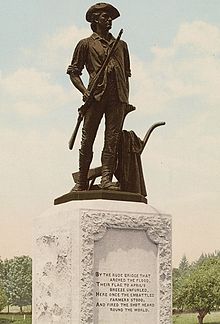Shot heard round the world

The "shot heard round the world" is a phrase that refers to the opening shot of the battles of Lexington and Concord on April 19, 1775, which sparked the American Revolutionary War and led to the creation of the United States. It originates from the opening stanza of Ralph Waldo Emerson's 1837 poem "Concord Hymn". The phrase has subsequently been applied to the assassination of Archduke Franz Ferdinand in 1914, a catalyst event for World War I, and hyperbolically applied to feats in sports.
American Revolutionary War
By the rude bridge that arched the flood,
Their flag to April’s breeze unfurled,
Here once the embattled farmers stood,
And fired the shot heard round the world.
− Emerson, "Concord Hymn"

Emerson's "Concord Hymn", which originated the phrase, was written about
There is no consensus whether the shots fired at the North Bridge were truly the first shots of the American Revolution; it is an unprovable matter of opinion and of contention, particularly between the towns of Concord and
Regardless of the facts of the matter, Emerson chose, in his poem, to characterize the later engagement at the North Bridge as the opening act of the Revolution. The North Bridge fight did see the first deliberate volley by Americans acting under orders, the first British deaths, and the first British retreat. A plaque on The Minute Man statue reads in part "On the 19 of April 1775 was made the first forcible resistance to British aggression..."[5]

The towns of Lexington and Concord have debated over the point where the first shot was fired since at least 1824, when Gilbert du Motier, Marquis de Lafayette visited the two towns during his visit to the United States. He was welcomed to Lexington by the municipal authorities, who described it as the "birthplace of American liberty"; the Marquis de Lafayette was subsequently informed in Concord that the "first forcible resistance" was made there.[citation needed] President Ulysses S. Grant considered not attending the 1875 centennial celebrations in the area to evade the issue.[citation needed] In 1894, Lexington petitioned the Massachusetts General Court to proclaim April 19 as "Lexington Day", to which Concord objected; the current name for the holiday is Patriots' Day.[6]
Assassination of Archduke Franz Ferdinand
Internationally, the phrase "shot heard round the world", alternatively written as "shots heard round the world" or "shot heard around the world", has become primarily associated with the assassination of Archduke Franz Ferdinand in Sarajevo on 28 June 1914.[7][8] The event is considered to be one of the immediate causes of World War I.[9][10][11][12] Serbian Gavrilo Princip fired two shots, the first hitting Franz Ferdinand's wife Sophie, Duchess of Hohenberg, and the second hitting the Archduke himself. The death of Franz Ferdinand, heir to the Austro-Hungarian throne, propelled Austria-Hungary and the rest of Europe into World War I.
Widespread idiomatic use
The phrase "Shot heard round the world" continues to be a stock phrase in the 21st century, widely used to refer to extraordinary events in general.[13] The phrase has been applied to several dramatic moments in sports history.
In baseball, the
In
In
References
- ^ "The Old Manse (U.S. National Park Service)". www.nps.gov. Retrieved April 3, 2023.
- ^ Derek W. Bett. "Who Shot First? The Americans!". Journal of the American Revolution. Retrieved August 10, 2023.
- ^ "First Shots of War, 1775 | The American Revolution, 1763 - 1783 | U.S. History Primary Source Timeline | Classroom Materials at the Library of Congress | Library of Congress". Library of Congress, Washington, D.C. 20540 USA. Retrieved April 3, 2023.
- ISBN 0-19-508847-6.
- ^ "1836 Battle Monument (U.S. National Park Service)". www.nps.gov. Retrieved April 3, 2023.
- ^ Brock Parker (April 28, 2014). "The old tavern debate: Which town fired first?". The Boston Globe. pp. B1, B13. Archived from the original on February 9, 2019. Retrieved February 9, 2019.
- ^ Michael D. Mosettig (June 27, 2014). "'The shots heard round the world' 100 years ago". PBS NewsHour. Archived from the original on September 11, 2018. Retrieved September 10, 2018.
- ^ Tom Parry (March 7, 2014). "My great uncle fired the shot that started World War I and I'm proud of him". Daily Mirror. Archived from the original on September 11, 2018. Retrieved September 10, 2018.
- History.com. Archivedfrom the original on September 11, 2018. Retrieved September 10, 2018.
- ^ Greg Allwood (June 28, 2016). "Sarajevo, June 28th – The Shot Heard Round The World". Forces Network. Archived from the original on September 11, 2018. Retrieved September 10, 2018.
- ^ Shea Lazansky (April 20, 2017). "The shot heard 'round Marion". The Daily Republican. Marion, Illinois. Archived from the original on September 11, 2018. Retrieved September 10, 2018.
- Cleveland.com. Archivedfrom the original on September 11, 2018. Retrieved September 10, 2018.
- ^ Candy Spelling (October 2, 2013). "Shot Heard 'Round the World". HuffPost Entertainment – The Blog. Archived from the original on October 21, 2013. Retrieved October 28, 2013.
- OL 8012779M.
- ^ a b " 'The shot' ends 40 years of hurt" Archived 2019-04-28 at the Wayback Machine, FIFA.com, September 10, 2015
- The Free Library.
- ^ Martin Davis (March 31, 2012). "Sarazen's double eagle put Masters on the map". Golf Channel. Archived from the original on June 4, 2020. Retrieved April 10, 2020.
